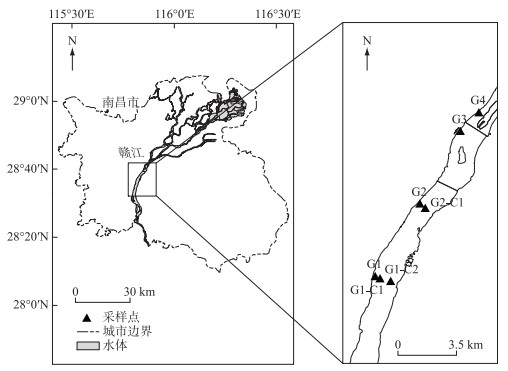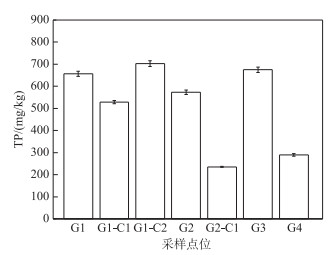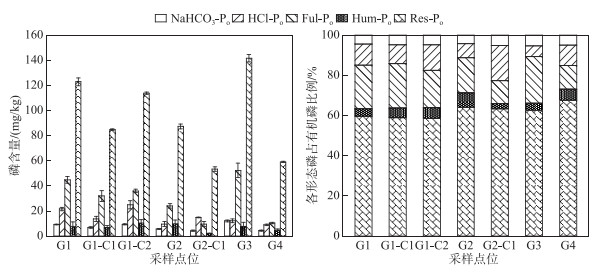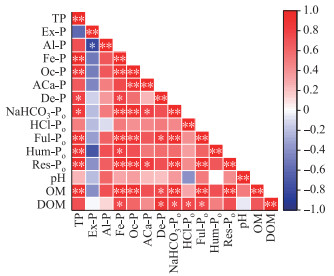(2: 江西省科学院微生物研究所, 南昌 330096)
(2: Institute of Microbiology, Jiangxi Academy of Sciences, Nanchang 330096, P.R.China)
氮、磷等营养盐是藻类和浮游生物生长必须的营养元素,在水环境中对生物群落结构和其他元素的生物地球化学循环起着至关重要的调节作用[1]。随着社会的发展,密集的人类活动产生的含有大量氮、磷营养盐的废水被排入到自然水体中,引发水藻类及浮游生物迅速增长,水体初级生产力提高,导致水体富营养化问题日益严重[2-3]。目前,水体富营养化已经成为全球性问题,根据联合国环境规划署(UNEP)的调查结果,全球范围内有1/3的水库和湖泊存在不同程度的富营养化问题[4]。中国许多淡水水体也普遍存在着富营养化现象,特别是长江三角洲地区和西南高原地区的湖泊富营养化问题尤为严重,水体富营养化已成为我国最为严重的水环境问题之一,严重威胁着水资源生态功能、人类健康和经济发展[5]。
磷元素是水生生态系统重要的限制性营养因子之一,磷浓度过高会加速初级生产,导致湖泊和水库富营养化[6]。水体中的磷元素按来源可分为外源输入和内源释放,当外源磷输入得到控制后,内源磷释放将成为水体主要的磷来源,会在较长时间内影响水体磷浓度,延缓水环境从富营养化状态的恢复,这一影响可能会持续长达十年甚至更久[7]。沉积物作为内源磷载体,是水生生态系统的重要组成部分,充当着磷元素“源”和“汇”的双重角色,在磷的地球生物化学循环过程中起着重要作用[8]。磷以各种形式存在于沉积物中,但并不是每一种赋存形态的磷都能从沉积物释放出来,一些磷组分实际上会永久埋藏在沉积物中,而另一些磷组分则具有潜在的流动性,在某些条件下容易释放到上覆水中[9]。沉积物中磷的赋存形态决定了其释放潜力和生物有效性,单以沉积物总磷难以准确地评估沉积物磷释放风险和对上覆水体的影响。因此,开展对沉积物磷赋存形态的研究,有助于了解沉积物中磷生物可利用程度,对预测内源磷负荷对上覆水体长期影响具有重要意义[10]。
赣江南昌段是南昌市的主要饮用水源地,同时承接了南昌市大部分的工业废水和生活污水[11]。水体中大量的磷元素淤积在河道底泥中,造成的水体污染问题将直接影响周边群众的用水安全[12]。已有调查显示,赣江水体已表现出富营养化趋势[13]。目前,对赣江南昌段磷营养盐的研究主要集中在上覆水水质方面,对沉积物内源磷释放的研究较少。为辨别赣江南昌段沉积物内源磷释放是否为蓝藻水华暴发的重要磷元素来源,本文以赣江南昌段表层沉积物为研究对象,利用化学连续提取法调查分析表层沉积物总磷含量及其赋存形态特征,探讨其生物有效性和内源释放风险,以期为赣江南昌段的水环境管理提供数据支撑和理论依据。
1 材料与方法 1.1 研究区域概况及样品采集赣江位于长江中下游,发源于赣闽边界武夷山西麓,全长766 km,自南向北贯穿江西省全省,流域面积83500 km2,占江西省国土面积的54%,占鄱阳湖流域面积的50.6%,是鄱阳湖流域第一大河流,也是长江八大支流之一。赣江流经赣抚平原后贯穿南昌市,南昌市地形以鄱阳湖平原为主,赣江把南昌市划分为“一江两岸”的格局,流经南昌市城区后分北支、中支、南支注入鄱阳湖,是周边工农业生产及生活用水的主要来源[12, 14]。
经实地考察并结合城市区域环境、人口活动及采样条件等,在赣江流经南昌主城区段,自赣江上游至下游共设置4个采样地点,并在4个地点的岸边设置G1、G2、G3和G4采样点位,其中G1位于南昌饮用水源取水区域,G4位于赣江南北分流区域。并于G1和G2区域江中位置加设G1-C1、G1-C2和G2-C1采样点位,采样点位置具体分布如图 1所示。于2022年5月使用有机玻璃采水器和抓斗型采泥器同步采集赣江南昌段(后文简称赣江)水体和表层沉积物(0~10 cm)样品。

|
图 1 采样点布置示意 Fig.1 Distribution of sampling sites |
采集的水样使用便携式水质分析仪(DZB-712F,上海雷磁)现场测定溶解氧(DO)、水温等理化指标,另一部分带回实验室测量总磷(TP)等水质指标。采集的沉积物装入聚乙烯塑料袋及时送回实验室冷冻保存。沉积物样品自然风干后,去除动植物残体、石块等杂质,研磨、过100目筛后置于干燥皿中保存待测,由于G2-C1和G4点位的沉积物样品中含有大量粒径较大的河砂,在沉积物预处理时因为过100目筛较为困难,此两点位选用60目筛进行过筛处理。
上覆水经30 min沉降后取上清液采用碱性过硫酸钾消解-钼酸铵分光光度法测定TP浓度,上覆水体溶解性活性磷(SRP)浓度采用钼酸铵分光光度法直接测定[15]。有机质(OM)采用灼失量法进行测定,用灼失量(LOI)表示。沉积物溶解性有机质(DOM)用0.01 mol/L KCl溶液提取(水土比,10∶1)[16],采用分光光度计法测定DOM的紫外可见光谱,DOM相对浓度以254 nm处吸收系数α254表示[17]。沉积物pH值采用超纯水(水土质量比2.5∶1)浸提后,利用pH计测定。
沉积物TP含量采用3.5 mol/L HCl提取[18]。各形态无机磷(IP)采用朱广伟等[19]改进的化学提取法分级提取,该方法将沉积物磷IP分为可交换态磷(Ex-P)、铝结合态磷(Al-P)、铁结合态磷(Fe-P)、闭蓄态磷(Oc-P)、自生钙磷(ACa-P)和碎屑钙磷(De-P)。各形态有机磷(OP)采用Ivanoff等[20]提出的化学提取法分级提取,该方法将沉积物OP分为活性有机磷(LOP),即碳酸氢钠提取态有机磷(NaHCO3-Po);中活性有机磷(MLOP),即盐酸提取态有机磷(HCl-Po)与富里酸提取态有机磷(Ful-Po)之和;非活性有机磷(NOP),即胡敏酸提取态有机磷(Hum-Po)与残渣态有机磷(Res-Po)之和。提取液TP含量采用过硫酸钾消解-钼酸铵分光光度法,IP含量采用钼酸铵分光光度法(其中Al-P由于含量较低,采用孔雀绿分光光度法测定)。沉积物IP总量和OP总量分别以各形态无机磷含量和各形态有机磷含量之和计算。沉积物生物有效磷(BAP)含量根据各形态磷的活性大小,以Ex-P、Al-P、Fe-P、NaHCO3-Po、HCl-Po和Ful-Po之和计算[21]。沉积物样品的测定均设置3个平行样。
等温吸附实验按照Long等[22]的方法:将0.5 g样品分别与40 mL不同浓度的KH2PO4溶液放入50 mL离心管,25℃下振荡24 h后离心,测定上清液磷浓度并计算磷吸附量。实验重复3次,结果取平均值。吸附数据利用修正的Langmuir模型拟合,拟合得到沉积物最大吸附容量(Qm)和磷平衡浓度(EPC0)[23]。沉积物磷吸附饱和度(DPS)参考相关文献计算[24-25],具体公式如下:
| $ D P S=\frac{B A P}{Q_{\mathrm{m}}+B A P} \times 100 \% $ | (1) |
使用ArcGIS 10.8软件进行采样点位图的绘制,使用Excel 2013软件进行数据处理,使用Origin 2021软件进行图表绘制,使用IBM SPSS Statistics 26.0软件对相关参数进行皮尔逊相关性分析。
2 结果与分析 2.1 上覆水与沉积物理化指标由表 1可知,赣江上覆水TP浓度为0.049~0.081 mg/L,基于《地表水环境质量标准》(GB 3838-2002),所有采样点均达到Ⅱ类水体要求。上覆水体SRP浓度为0.036~0.039 mg/L,不同点位间SRP浓度变化较小。SRP占TP的比例为44.44%~75.51%,平均为63.76%±12.07%,表明赣江水体TP主要以溶解态活性磷为主要形态。DO浓度为6.8~7.4 mg/L,呈现弱富氧状态。沉积物的pH为6.59~7.22,平均值为6.94±0.10,总体呈中性。
| 表 1 赣江上覆水与沉积物理化性质 Tab. 1 Physical and chemical properties of overlying water and sediment in Ganjiang River |
赣江表层沉积物TP含量范围为235.21~702.24 mg/kg,平均含量为522.93 mg/kg。赣江南表层沉积物TP含量变异系数为36.0%,表明TP含量具有较高的空间异质性(图 2)。但剔除G2-C1和G4两个点位(TP含量远低于其他点位,约为其余5个点位的一半)后,其余点位TP含量的变异系数约为11.6%。G2和G2-C1采样点相距较近,两者TP含量却相差近一倍,这可能与赣江中存在的采砂作业和频繁的航运作业破坏了原有的河床沉积环境有关。

|
图 2 表层沉积物TP含量分布 Fig.2 Contents of TP in surface sediment |
赣江沉积物IP含量为174.91~569.34 mg/kg,平均含量为372.49 mg/kg。不同赋存形态无机磷含量分布及占无机磷总量的比例如图 3所示,所有采样点位中均以Oc-P为主要赋存形态,各形态磷平均含量表现为Oc-P>Fe-P>De-P>ACa-P>Ex-P>Al-P。其中Ex-P和Al-P含量均小于11 mg/kg,在IP中占比较小;Oc-P、Fe-P和De-P含量的空间分布与TP含量类似,表现出明显的空间异质性,但沿程分布无明显趋势。

|
图 3 表层沉积物不同形态无机磷含量及占无机磷总量的比例 Fig.3 The contents of different forms of inorganic phosphorus and their proportion of the total inorganic phosphorus in surface sediment |
赣江沉积物OP含量为84.15~225.84 mg/kg,平均含量为153.98 mg/kg(图 4)。Res-Po为沉积物OP的主要赋存形态,其次为Ful-Po和HCl-Po,NaHCO3-Po和Hum-Po含量最低。按有机磷活性划分,整体表现为NOP>MLOP>LOP。各采样点位不同形态OP含量沿程分布无明显趋势。

|
图 4 表层沉积物不同形态有机磷含量及占有机磷总量的比例 Fig.4 The contents of different forms of organic phosphorus and their proportion of the total organic phosphorus in surface sediment |
赣江表层沉积物BAP含量范围为61.59~218.27 mg/kg,平均含量为145.54 mg/kg(表 2),各采样点位BAP含量分布与TP趋于一致。沉积物EPC0为0.126~0.209 mg/L,平均值为0.156 mg/L,所有采样点位均高于上覆水SRP浓度。沉积物DPS范围为8.79%~23.31%,平均值为15.73%。
| 表 2 赣江表层沉积物生物有效磷及吸附参数 Tab. 2 Bioavailable phosphorus and adsorption parameters in surface sediments of Ganjiang River |
通过与我国其他流经城市江河水体、城市市内河网及赣江下游汇入的鄱阳湖表层沉积物TP含量对比,赣江沉积物TP含量整体处于较低水平(表 3)。TP含量均值与巢湖流域的丰乐河相似,略低于岷江和鄱阳湖。与成都市和嘉兴市的城内河网相比,赣江表层沉积物TP含量整体处于较低水平,这可能与赣江作为长江流域主要支流,江水流速较快、水力停留时间短有关。TP含量表现出显著的空间异质性,但组成上整体表现出一致性,这可能主要受沉积物中OM含量影响。OM是沉积物中营养物质的重要载体,为磷酸盐提供了大量吸附位点,增加了沉积物的吸附容量[26]。同时,沉积物中磷的迁移转化在很大程度上也是由与有机质矿化有关的初级和次级氧化还原反应驱动的[27]。赣江沉积物OM含量与TP、Fe-P、Oc-P、De-P、NaHCO3-Po、Ful-Po和Res-Po均存在显著的相关性(P<0.05,图 5),表明赣江沉积物中有机质是影响磷素水平的重要因素。
| 表 3 赣江与其国内他水体表层沉积物TP含量比较 Tab. 3 Comparison of TP content in surface sediments of Ganjiang River and other water bodies in China |

|
图 5 沉积物各赋存磷形态与理化性质之间Pearson相关性分析(图案颜色红色为正相关,蓝色为负相关,其颜色深浅对应相关性的大小;*: P<0.05,**: P<0.01) Fig.5 Pearson correlation analysis between different forms of phosphorus and physicochemical properties in sediments (Red indicates a positive correlation, blue indicates a negative correlation, and the depth of the pattern colour represents the magnitude of the correlation; *: P < 0.05, **: P < 0.01) |
赣江表层沉积物IP以Oc-P为主要赋存形态,其次为Fe-P。Fe-P是与Fe、Al、Mn等金属的氧化物及氢氧化物结合形成的磷,其对于环境变化非常敏感,在还原条件下易于分解[33]。沉积物Fe-P累积与工业和生活污水排放密切相关,沉积物中Fe-P含量可以作为指示工业和生活污水中磷输入的良好指标[34]。生活污水和工业污水的输入向水体引入大量铁和磷,具有较大比表面积的铁氧化物可通过化学键形式与磷酸根在表面吸附位点形成单基配位或双基配位对磷酸盐形成高度吸附[35-36]。本次调查的采样点也大部分位于城市的核心区域,生活污水及工业污水的输入可能是导致赣江Fe-P高占比的重要原因。同时非点源污染也是城市水体污染不可忽视的因素之一,雨水冲刷城市路面会导致其中携带的大量N、P等营养盐及Fe、Al、Mn等金属元素,并通过雨水径流输入水体[37]。相关性分析结果(图 5)显示,TP与Fe-P之间相关系数最大,说明Fe-P含量的变化对沉积物TP积累的贡献最大。TP和Fe-P均与反映外源输入作用的De-P存在显著相关关系(P<0.05),与反映内源自生性的ACa-P相关性不大,表明赣江沉积物TP的累积可能主要源于外源输入[38]。
赣江表层沉积物中有机磷含量占TP的平均比例为29.92%,低于下游鄱阳湖[39]的40%。相关研究表明,水体中的磷元素以工业和生活污染为主要来源的沉积物中有机磷相对含量往往低于以农业面源污染为主的沉积物[40]。有机磷中以较为稳定的Res-Po为主要赋存形态,具有潜在生物有效性的LOP和MLOP占比为33.24%,与洪泽湖主要入湖河流[41](占比>43%),闽江上游河流[42](占比>44%)相比,赣江有机磷的生物有效性处于处于较低水平。刘哲哲等[43]的研究表明,相比于SRP,再悬浮过程中沉积物中溶解态有机磷(DOP)释放可更快达到平衡,且释放量较大。赣江复杂的水文环境及航运等人类活性可能造成了沉积物频繁再悬浮,具有生物活性的OP组分发生了大量流失[44]。NaHCO3-Po与Ful-Po和Res-Po均存在极显著的相关关系(P<0.01,图 5),可能是由于非活性有机磷在一定条件下可以向活性更高的形态转化[45]。DOM与有机磷中的NaHCO3-Po、HCl-Po和Ful-Po等活性有机磷组分存在显著相关性(P<0.05),表明有机磷中活性组分的含量受到OM中DOM比例的影响。NaHCO3-Po、Ful-Po、Hum-Po以及Res-Po均与Fe-P存在显著的相关关系(P<0.05),这可能是其共同受到金属离子及其氧化物调控的结果。金属氧化物是有机磷的主要结合介质,金属氧化物含量变化,或者由于氧化还原条件变化引起的金属氧化物形态变化将影响有机磷结合程度[46]。Ful-Po和Hum-Po被认为是铁/铝结合态有机磷,主要成分为肌醇五磷酸和肌醇六磷酸,但两者活性存在差异[47]。铁/铝氧化物可以通过表面的H2O和-OH与磷酸基配位交换吸附肌醇磷酸,参与配位交换的磷酸基数目与分子排列方式则取决于氧化物表面的性质[48]。Zhu等[49]的研究表明,一些有机磷特别是植酸类磷(Res-Po的主要成分),被矿物质如Fe和Al的氧化物、氢氧化物固定保护,是其抵抗磷酸酶水解的重要机制,从而使这部分有机磷被保存在沉积物中。
3.2 沉积物磷的释放风险BAP是指沉积物中潜在的容易释放出来被水生生物直接利用的或可通过自然过程转化为有效形式的磷[50]。赣江沉积物BAP占TP的比例为21.24%~32.35%,平均占比为27.07%。与珠江水系的漫水河[51]、嘉兴城市河网[31]、泗河[52]等河流相比,赣江沉积物BAP总量和占TP比例均处于较低水平。赣江沉积物BAP中Fe-P平均占比达到51.61%,表明赣江沉积物磷潜在释放风险主要来自于Fe-P。沉积物磷的迁移转化易受到pH值与氧化还原条件的影响,相较于酸性和碱性条件,中性条件下沉积物磷释放量最小[53]。赣江沉积物总体处于中性,pH值对沉积物磷吸附释放的影响较小,这也可能是赣江沉积物pH与所有形态磷未表现出显著相关性的主要原因(图 5)。水体中DO浓度会改变沉积物-水界面中的氧化还原条件,最终影响沉积物磷的吸附与释放[54]。本次调查结果显示,赣江水体总体处于弱富氧状态(DO=6.8~7.4 mg/L),并未出现水体缺氧情形。因此,赣江的水化学环境对Fe-P释放的促进作用较小。
EPC0通常用于评估沉积物-水界面处磷的交换行为,通过与上覆水SRP浓度对比,判断沉积物处于“磷汇”或“磷源”状态[55]。采样期间赣江所有点位的沉积物EPC0均高于上覆水SRP浓度,表明赣江沉积物当前处于“磷源”状态。沉积物磷的迁移转化具有明显的季节模式,春冬季通常表现为净吸附,夏季则表现为净释放[56]。也有研究表明,沉积物的EPC0常随着温度的升高而降低,在冬春季节EPC0通常处于一年中的高值;进入夏季温度逐渐升高,随着高活性磷的释放,EPC0也随之降低[57]。本研究采样时间处于春末,水温已上升至22℃,本次调查结果得出,此时赣江沉积物处于“磷源”状态,与沉积磷迁移转化的季节性变化规律相符。鉴于EPC0无法准确衡量沉积物磷可能发生的释放程度,本研究进一步结合DPS指标对沉积物磷释放潜力进行分析。DPS是通过沉积物当前磷含量水平与沉积物最大磷吸能力比值评估沉积物磷潜在流失风险的指标,DPS值越大,沉积物对磷的缓冲能力越小,向上覆水释放的风险越高[58-59]。25%可作为DPS的阈值,高于该阈值时沉积物具有较高的可解吸磷可能释放到上覆水体中[24]。赣江所有采样点位的沉积物DPS均低于25%,表明赣江沉积物具有大量未被占用的磷吸附位点,对上覆水磷浓度的缓冲能力较强。由此可见,这一阶段沉积物虽然可能处于释磷状态,但沉积物呈现大量磷释放特征的可能性并不高。结合上节分析结论,即赣江表层沉积物TP含量总体处于较低水平,且无机磷和有机磷分别以较为稳定Oc-P和Res-Po为主要赋存形态,BAP含量较低。因此,沉积物内源磷释放引起赣江水体富营养化的风险不高,赣江水质管理应更多关注外源输入问题,该研究成果可为赣江南昌段水环境管理提供数据支撑和科学依据。
4 结论1) 赣江南昌段沉积物TP含量为235.21~702.24 mg/kg,平均含量为522.93 mg/kg,各采样点位TP含量存在明显差异。IP为TP主要形态,平均含量为372.49 mg/kg,不同形态IP含量表现为:Oc-P>Fe-P>De-P>ACa-P>Ex-P>Al-P。OP平均含量为153.98 mg/kg,以Res-Po为主要赋存形态,按有机磷活性划分,各形态有机磷含量表现为NOP>MLOP>LOP。
2) 赣江南昌段沉积物BAP含量范围为61.59~218.27 mg/kg,平均含量为145.54 mg/kg。BAP占TP比例为21.24%~32.35%,平均占比为27.07%。与国内其他水体相比,BAP总量及占TP比例均处于较低水平。Fe-P在BAP占比较高,表明赣江内源磷潜在释放风险主要来自于Fe-P,但pH和氧化还原条件等水化学因子对Fe-P释放的促进作用较小。
3) 赣江南昌段沉积物EPC0高于上覆水SRP,此阶段沉积物可能作为上覆水的“磷源”,符合沉积物磷迁移转化的季节性特征。所有采样点位的DPS值均低于沉积物磷大量流失的临界值25%,因此沉积物呈现大量磷释放特征的可能性并不高。
| [1] |
Bastami KD, Neyestani MR, Raeisi H et al. Bioavailability and geochemical speciation of phosphorus in surface sediments of the Southern Caspian Sea. Marine Pollution Bulletin, 2018, 126: 51-57. DOI:10.1016/j.marpolbul.2017.10.095 |
| [2] |
Yuan HZ, Cai YW, Yang Z et al. Phosphorus removal from sediments by Potamogeton crispus: New high-resolution in-situ evidence for rhizosphere assimilation and oxidization-induced retention. Journal of Environmental Sciences, 2021, 109: 181-192. DOI:10.1016/j.jes.2021.04.010 |
| [3] |
Chen P, Ni LQ. Research progress on nitrogen and phosphorus migration and transformation in river and lake sediments. Journal of Xuzhou Institute of Technology: Natural Sciences Edition, 2020, 35(2): 60-66. [陈平, 倪龙琦. 河湖底泥中氮磷迁移转化的研究进展. 徐州工程学院学报: 自然科学版, 2020, 35(2): 60-66.] |
| [4] |
Li AZ, Chen SX, Li HY et al. Characteristics and evaluation of eutrophication in major reservoirs of a northern city in China. Environmental Chemistry, 2020, 39(9): 2529-2539. [李昂臻, 陈思旭, 李海燕等. 北方某省会城市主要水库富营养化程度、特征和防治对策. 环境化学, 2020, 39(9): 2529-2539. DOI:10.7524/j.issn.0254-6108.2020040902] |
| [5] |
Xie FZ, Li L, Song K et al. Characterization of phosphorus forms in a Eutrophic Lake, China. Science of the Total Environment, 2019, 659: 1437-1447. DOI:10.1016/j.scitotenv.2018.12.466 |
| [6] |
Varol M. Spatio-temporal changes in surface water quality and sediment phosphorus content of a large reservoir in Turkey. Environmental Pollution, 2020, 259: 113860. DOI:10.1016/j.envpol.2019.113860 |
| [7] |
Li R, Gao L, Wu QR et al. Release characteristics and mechanisms of sediment phosphorus in contaminated and uncontaminated rivers: A case study in South China. Environmental Pollution, 2021, 268: 115749. DOI:10.1016/j.envpol.2020.115749 |
| [8] |
He YY, Chen JY, Gao L et al. Spatial and temporal variations of sediment nutrients and relevant sources identification in Baipenzhu Reservoir, Guangdong province. Ecology and Environment Sciences, 2020, 29(7): 1419-1426. [何宜颖, 陈建耀, 高磊等. 惠州白盆珠水库沉积物营养元素时空变化特征及源解析. 生态环境学报, 2020, 29(7): 1419-1426.] |
| [9] |
Zhang RM, Yin AJ, Gao C. Sediment phosphorus fraction and release potential in the major inflow rivers of Chaohu Lake, Eastern China. Environmental Earth Sciences, 2019, 78(4): 117. DOI:10.1007/s12665-019-8086-6 |
| [10] |
Xie FZ, Luo K, Zhu YR et al. Characteristics of phosphorus fractions in sediments and its influence on the water quality of Lake Nanyi. China Environmental Science, 2022, 42(11): 5318-5327, 1-13. [谢发之, 罗锟, 朱元荣等. 南漪湖沉积物磷的赋存形态及对上覆水的影响研究. 中国环境科学, 2022, 42(11): 5318-5327, 1-13.] |
| [11] |
Hu FP, Hou J, Luo JW et al. Analysis of pollution loading and water environmental capacity of Gan River in Nanchang. Environmental Science & Technology, 2010, 33(12): 192-195, 205. [胡锋平, 侯娟, 罗健文等. 赣江南昌段污染负荷及水环境容量分析. 环境科学与技术, 2010, 33(12): 192-195, 205. DOI:10.3969/j.issn.1003-6504.2010.12.046] |
| [12] |
Song KL, Wang LN, Lin YH et al. Analysis on community structure of ammonia oxidizing microorganisms in Nanchang section of Ganjiang River in wet and dry season. Environmental Pollution & Control, 2022, 44(11): 1484-1490. [宋凯伦, 汪丽娜, 林益寰等. 赣江南昌段丰、枯水期氨氧化微生物群落结构分析. 环境污染与防治, 2022, 44(11): 1484-1490.] |
| [13] |
Lu L, Xie FL. Research on the factors of Ganjiang River water nitrogen and phosphorus distribution characteristics and influence. Journal of Nanchang University: Natural Science, 2017, 41(6): 567-571. [卢龙, 谢芳立. 赣江水体氮磷营养盐分布特征及影响因素. 南昌大学学报: 理科版, 2017, 41(6): 567-571.] |
| [14] |
Wang JJ, Xia Y, Yu XP et al. Temporal and spatial distribution characteristics and water quality evaluation of planktonic algae in the middle and lower re aches of Ganjiang River. Journal of Ecology and Rural Environment, 2023, 39(8): 1031-1041. [王俊颉, 夏雨, 于新平等. 赣江中下游浮游藻类时空分布特征及水质评价. 生态与农村环境学报, 2023, 39(8): 1031-1041. DOI:10.19741/j.issn.1673-4831.2022.0235] |
| [15] |
国家环境保护总局, 水和废水监测分析方法编委会编. 水和废水监测分析方法(第四版). 北京: 中国环境科学出版社, 2002.
|
| [16] |
Wang YF, Zhang XY, Zhang X et al. Characterization of spectral responses of dissolved organic matter (DOM) for atrazine binding during the sorption process onto black soil. Chemosphere, 2017, 180: 531-539. DOI:10.1016/j.chemosphere.2017.04.063 |
| [17] |
龙云川. 贵州草海表层沉积物DOM与微生物对磷的地球化学特征影响研究[学位论文]. 贵阳: 贵州大学, 2022.
|
| [18] |
Ruban V, López-Sánchez JF, Pardo P et al. Harmonized protocol and certified reference material for the determination of extractable contents of phosphorus in freshwater sediments—A synthesis of recent works. Fresenius' Journal of Analytical Chemistry, 2001, 370(2): 224-228. DOI:10.1007/s002160100753 |
| [19] |
Zhu GW, Qin BQ, Gao G et al. Fractionation of phosphorus in sediments and its relation with soluble phosphorus contents in shallow lakes located in the middle and lower reaches of Changjiang River, China. Acta Scientiae Circumstantiae, 2004, 24(3): 381-388. [朱广伟, 秦伯强, 高光等. 长江中下游浅水湖泊沉积物中磷的形态及其与水相磷的关系. 环境科学学报, 2004, 24(3): 381-388. DOI:10.13671/j.hjkxxb.2004.03.003] |
| [20] |
Ivanoff DB, Reddy KR, Robinson S. Chemical fractionation of organic phosphorus in selected histosols1. Soil Science, 1998, 163(1): 36-45. DOI:10.1097/00010694-199801000-00006 |
| [21] |
Pu J, Ni ZK, Wang SR. Characteristics of bioavailable phosphorus in sediment and potential environmental risks in Poyang Lake: The largest freshwater lake in China. Ecological Indicators, 2020, 115: 106409. DOI:10.1016/j.ecolind.2020.106409 |
| [22] |
Long YC, Hu XJ, Jiang J et al. Phosphorus sorption-desorption behaviors in the sediments cultured with Hydrilla verticillata and Scripus triqueter as revealed by phosphorus fraction and dissolved organic matter. Chemosphere, 2021, 271: 129549. DOI:10.1016/j.chemosphere.2021.129549 |
| [23] |
Bai JH, Ye XF, Jia J et al. Phosphorus sorption-desorption and effects of temperature, pH and salinity on phosphorus sorption in marsh soils from coastal wetlands with different flooding conditions. Chemosphere, 2017, 188: 677-688. DOI:10.1016/j.chemosphere.2017.08.117 |
| [24] |
Zhang X, Zhu B. Distribution and release potential of soil phosphorus fractions in water-level-fluctuation zone of the tributary bay, Three Gorges Reservoir. Environmental Science, 2023, 44(5): 2574-2582. [张雪, 朱波. 三峡库区支流库湾消落带土壤磷形态赋存特征及其释放风险. 环境科学, 2023, 44(5): 2574-2582. DOI:10.13227/j.hjkx.202205097] |
| [25] |
Li M, Hou YL, Zhu B. Phosphorus sorption-desorption by purple soils of China in relation to their properties. Soil Research, 2007, 45(3): 182. DOI:10.1071/sr06135 |
| [26] |
Xiang SL, Wu TZ, Gong CY et al. Effects of organic matter removal on nitrogen and phosphorus release characteristics from surface sediments in urban shallow lakes. Bulletin of Soil and Water Conservation, 2021, 41(5): 9-14, 74. [向速林, 吴涛哲, 龚聪远等. 去除有机质对城市浅水湖泊氮磷释放特征的影响. 水土保持通报, 2021, 41(5): 9-14, 74.] |
| [27] |
Mort HP, Slomp CP, Gustafsson BG et al. Phosphorus recycling and burial in Baltic Sea sediments with contrasting redox conditions. Geochimica et Cosmochimica Acta, 2010, 74(4): 1350-1362. DOI:10.1016/j.gca.2009.11.016 |
| [28] |
Yang G, Qin YW, Han CN et al. Distribution of phosphorus fractions in surface sediments of Minjiang mainstreams. Environmental Science, 2018, 39(5): 2165-2173. [杨耿, 秦延文, 韩超南等. 岷江干流表层沉积物中磷形态空间分布特征. 环境科学, 2018, 39(5): 2165-2173. DOI:10.13227/j.hjkx.201708130] |
| [29] |
Jiang XX, Sun Y, Chu Y et al. Study on phosphorus fractions in river sediments of typical watersheds of Chao Lake basin. Journal of Anhui Agricultural University, 2021, 48(6): 960-967. [姜晓霞, 孙玥, 储茵等. 巢湖典型流域河道沉积物磷赋存形态研究. 安徽农业大学学报, 2021, 48(6): 960-967.] |
| [30] |
Ding Y, Ouyang LL, Shi Q et al. Distribution and bioavability of phosphorus in surface sediments in megalopolis: A case study of Chengdu. Environmental Science, 2019, 40(1): 219-227. [丁瑶, 欧阳莉莉, 石清等. 特大城市河流表层沉积物磷形态分布及有效性: 以成都市为例. 环境科学, 2019, 40(1): 219-227. DOI:10.13227/j.hjkx.201805193] |
| [31] |
Huang W, Jin ZH, Tu CQ et al. Distribution characteristics and release risk of phosphorus forms in a urban river network region. Acta Scientiae Circumstantiae, 2022, 42(12): 171-185. [黄威, 靳郑海, 凃成琪等. 城市河网区河流沉积物磷形态分布特征及释放贡献. 环境科学学报, 2022, 42(12): 171-185. DOI:10.13671/j.hjkxxb.2022.0130] |
| [32] |
Xiang SL, Zhou WB. Phosphorus existing forms and instribution characteristic in Lake Poyang sediments. J Lake Sci, 2010, 22(5): 649-654. [向速林, 周文斌. 鄱阳湖沉积物中磷的赋存形态及分布特征. 湖泊科学, 2010, 22(5): 649-654. DOI:10.18307/2010.0504] |
| [33] |
Wu M, Huang SL, Wen W et al. Nutrient distribution within and release from the contaminated sediment of Haihe River. Journal of Environmental Sciences: China, 2011, 23(7): 1086-1094. DOI:10.1016/s1001-0742(10)60491-3 |
| [34] |
Liu YJ, Huang SZ, Zhang L et al. Spatial distribution characteristics of phosphorus fractions and release risk in sediments of Honghu international importance wetland. Environmental Science, 2021, 42(7): 3198-3205. [刘永九, 黄素珍, 张璐等. 洪湖国际重要湿地沉积物磷空间分布特征及释放风险. 环境科学, 2021, 42(7): 3198-3205. DOI:10.13227/j.hjkx.202009090] |
| [35] |
Yang B, Lan RZ, Lu DL et al. Phosphorus biogeochemical cycling in intertidal surface sediments from the Maowei Sea in the northern Beibu Gulf. Regional Studies in Marine Science, 2019, 28: 100624. DOI:10.1016/j.rsma.2019.100624 |
| [36] |
Wang Chao, Zou LM, Wang PF et al. Distribution and correlation of P and Fe fractions in sediments of typical urban shallow lakes. Environmental Science, 2008, 29(12): 3400-3404. [王超, 邹丽敏, 王沛芳等. 典型城市浅水湖泊沉积物中磷与铁的形态分布及相关关系. 环境科学, 2008, 29(12): 3400-3404. DOI:10.13227/j.hjkx.2008.12.041] |
| [37] |
Zhang Y. Research on urban initial stormwater pollution treatment technology. Anhui Agricultural Science Bulletin, 2020, 26(21): 141-143. [张银. 城市初期雨水污染处理技术研究. 安徽农学通报, 2020, 26(21): 141-143.] |
| [38] |
靳慧慧. 向家坝库区沉积物中磷的形态分布特征及风险评价[学位论文]. 邯郸: 河北工程大学, 2021.
|
| [39] |
Ni ZK, Wang SR, Wu Y et al. Influence of exposure time on phosphorus composition and bioavailability in wetland sediments from Poyang Lake, since the operation of the Three Gorges Dam. Environmental Pollution, 2020, 263: 114591. DOI:10.1016/j.envpol.2020.114591 |
| [40] |
Li QQ, Huo SL, Zan FY et al. The distribution of nutrients and particle size, their correlations in surface sediments of different lakes, China. Journal of Agro-Environment Science, 2010, 29(12): 2390-2397. [李青芹, 霍守亮, 昝逢宇等. 我国湖泊沉积物营养盐和粒度分布及其关系研究. 农业环境科学学报, 2010, 29(12): 2390-2397. DOI:10.1007/s12665-023-11202-9] |
| [41] |
Han N, Yuan XY, Zhou HH et al. Distribution characteristics of organic phosphorus in the sediments of rivers entering the Lake Hongze and the effects of exogenous substances on their fraction transformation. J Lake Sci, 2020, 32(3): 665-675. [韩年, 袁旭音, 周慧华等. 洪泽湖入湖河流沉积物有机磷分布特征及外源输入对其形态转化的影响. 湖泊科学, 2020, 32(3): 665-675. DOI:10.18307/2020.0307] |
| [42] |
Xu Jian, Yuan XY, Ye HM et al. Spatial distribution of organic phosphorus in sediment and its environmental implication in the upper stream of Minjiang River. Environmental Science, 2019, 40(5): 2186-2193. [徐健, 袁旭音, 叶宏萌等. 闽江上游溪流沉积物有机磷空间分布及其环境意义分析. 环境科学, 2019, 40(5): 2186-2193. DOI:10.13227/j.hjkx.201809225] |
| [43] |
Liu ZZ, Ni ZK, Liu SR et al. Kinetic release characteristics of organic phosphorus of sediment-water and water quality risks. Environmental Science, 2022, 43(6): 3058-3065. [刘哲哲, 倪兆奎, 刘思儒等. 湖泊沉积物有机磷释放动力学特征及水质风险. 环境科学, 2022, 43(6): 3058-3065. DOI:10.13227/j.hjkx.202110121] |
| [44] |
Ma SL, Ni ZK, Wang SR et al. Organic phosphorus forms in sediments and their relationship with the change of water level in Poyang Lake. Acta Scientiae Circumstantiae, 2016, 36(10): 3607-3614. [马双丽, 倪兆奎, 王圣瑞等. 鄱阳湖沉积物有机磷形态及对水位变化响应. 环境科学学报, 2016, 36(10): 3607-3614. DOI:10.13671/j.hjkxxb.2016.0073] |
| [45] |
Yuan HZ, Tai ZQ, Li Q et al. Characterization and source identification of organic phosphorus in sediments of a hypereutrophic lake. Environmental Pollution, 2020, 257: 113500. DOI:10.1016/j.envpol.2019.113500 |
| [46] |
Zhang Y, Song JW, Lv YC et al. Bioavailability and variations of organic phosphorus in sediments of Swan Lake, Rongcheng. Acta Scientiae Circumstantiae, 2017, 37(12): 4629-4635. [张友, 宋佳伟, 吕迎春等. 荣成天鹅湖沉积物有机磷的生物有效性及其时空动态. 环境科学学报, 2017, 37(12): 4629-4635. DOI:10.13671/j.hjkxxb.2017.0224] |
| [47] |
卢艳敏, 张靖天, 张新波等. 巢湖沉积物中有机磷的生物可利用性研究. 环境工程技术学报, 2020, 10(2): 197-204. |
| [48] |
严玉鹏. 几种土壤有机磷在铁铝氧化物表面的吸附、解吸与沉淀[学位论文]. 武汉: 华中农业大学, 2015.
|
| [49] |
Zhu YR, Feng WY, Liu SS et al. Bioavailability and preservation of organic phosphorus in lake sediments: Insights from enzymatic hydrolysis and 31P nuclear magnetic resonance. Chemosphere, 2018, 211: 50-61. DOI:10.1016/j.chemosphere.2018.07.134 |
| [50] |
Boström B, Persson G, Broberg B. Bioavailability of different phosphorus forms in freshwater systems. Hydrobiologia, 1988, 170(1): 133-155. DOI:10.1007/BF00024902 |
| [51] |
Huang MN, Ning XA, Zhang JY et al. Characteristics of phosphorus pollution in Manshui River and the effects of fulvic acid on phosphorus release from sediments. Chinese Journal of Environmental Engineering, 2022, 16(5): 1549-1557. [黄镁宁, 宁寻安, 张建易等. 漫水河清远流域磷污染特征及富里酸对沉积物释磷的影响. 环境工程学报, 2022, 16(5): 1549-1557. DOI:10.12030/j.cjee.202112023] |
| [52] |
Zhang ZH, Zhang XR, Jia CX et al. Chemical forms and spatial distribution of phosphorus in the sediment of Sihe River. Environmental Science, 2022, 43(7): 3587-3596. [张子涵, 张鑫茹, 贾传兴等. 泗河水系沉积物磷的存在形态及其空间分布特征. 环境科学, 2022, 43(7): 3587-3596. DOI:10.13227/j.hjkx.202108226] |
| [53] |
Chen J, Xu H, Zhan X et al. Mechanisms and research methods of phosphorus migration and transformation across sediment-water interface. J Lake Sci, 2019, 31(4): 907-918. [陈洁, 许海, 詹旭等. 湖泊沉积物—水界面磷的迁移转化机制与定量研究方法. 湖泊科学, 2019, 31(4): 907-918. DOI:10.18307/2019.0416] |
| [54] |
Rahutomo S, Kovar JL, Thompson ML. Phosphorus transformations in stream bank sediments in Iowa, USA, at varying redox potentials. Journal of Soils and Sediments, 2019, 19(2): 1029-1039. DOI:10.1007/s11368-018-2139-4 |
| [55] |
Zhu GR, Yang Y. Variation laws and release characteristics of phosphorus on surface sediment of Dongting Lake. Environmental Science and Pollution Research, 2018, 25(13): 12342-12351. DOI:10.1007/s11356-018-1777-9 |
| [56] |
Søndergaard M, Bjerring R, Jeppesen E. Persistent internal phosphorus loading during summer in shallow eutrophic lakes. Hydrobiologia, 2013, 710(1): 95-107. DOI:10.1007/s10750-012-1091-3 |
| [57] |
Huang W, Chen X, Wang K et al. Seasonal characteristics of phosphorus sorption by sediments from plain lakes with different trophic statuses. Royal Society Open Science, 2018, 5(8): 172237. DOI:10.1098/rsos.172237 |
| [58] |
Gao DZ, Chen GX, Li XF et al. Reclamation culture alters sediment phosphorus speciation and ecological risk in coastal zone of southeastern China. CLEAN-Soil, Air, Water, 2018, 46(11): 1700495. DOI:10.1002/clen.201700495 |
| [59] |
Song JW, Xu G, Zhang Y et al. Phosphorus storage capacity and loss risk in coastal reed wetland surrounding Bohai Sea. Environmental Science, 2020, 41(2): 728-733. [宋佳伟, 徐刚, 张扬等. 环渤海芦苇湿地磷的吸附容量及释放风险评估. 环境科学, 2020, 41(2): 728-733. DOI:10.13227/j.hjkx.201908013] |
 2024, Vol. 36
2024, Vol. 36 

